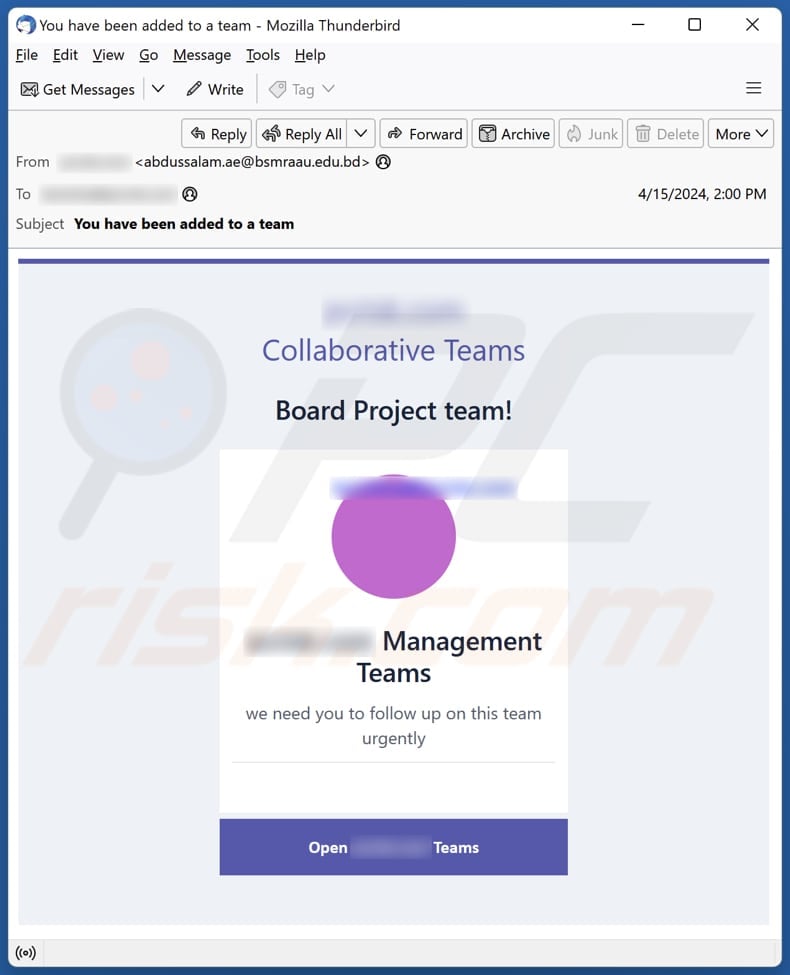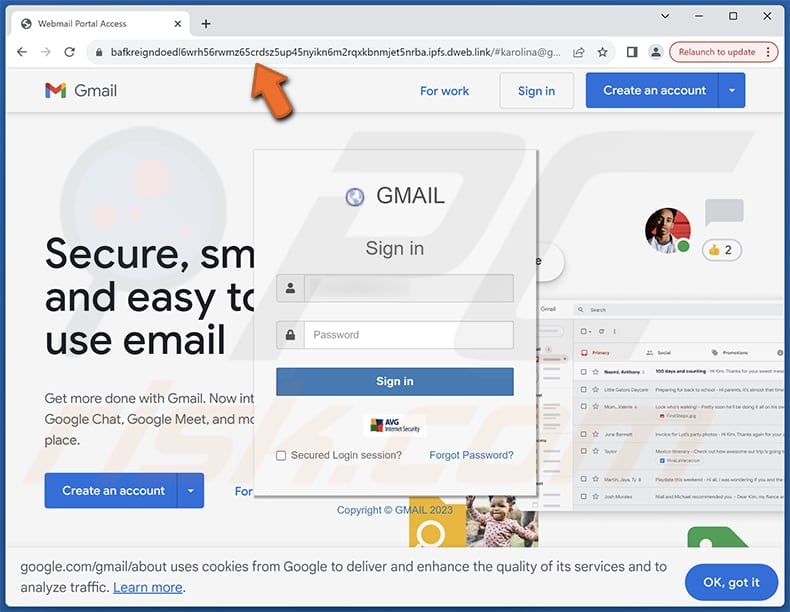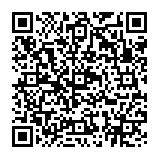How to avoid falling for phishing campaigns like "Collaborative Teams"
![]() Written by Tomas Meskauskas on
Written by Tomas Meskauskas on
What is "Collaborative Teams" scam email?
During our investigation, we discovered that this email is a phishing attempt, falsely urging recipients to take specific actions. Phishing emails often masquerade as legitimate communications from trusted entities, aiming to deceive recipients into divulging personal information or performing actions that could compromise their security. Thus, this and similar emails should be ignored.

More about the "Collaborative Teams" scam email
This phishing email impersonates a notification from a collaboration platform, falsely claiming that the recipient has been added to a team called "Board Project" or similar. The subject line "You have been added to a team" aims to induce urgency and prompt the recipient to take action.
The email seems to be from a reliable source, possibly mimicking a well-known collaboration tool like Microsoft Teams or Slack, as indicated by the mention of "Collaborative Teams" and "Management Teams". The urgency is emphasized with the request to follow up urgently. However, the email contains a suspicious link leading to a phishing page designed to steal login credentials.
By clicking the provided button, recipients are directed to a counterfeit Gmail login page, prompting users to enter their email address and password for authentication. It is crucial to mention that this deceptive site may replicate other email service providers such as Yahoo! Mail.
When scammers successfully acquire email account login credentials, they access the victim's contact list and send out phishing emails or spam messages, potentially infecting more systems or perpetuating the scam. Also, scammers may search the victim's emails for sensitive information such as financial details, personal data, or login credentials for other accounts.
Moreover, they may attempt to use the same credentials to access other accounts, such as social media accounts, online banking, gaming, and more. By gaining access to multiple accounts, scammers can exploit the victim's personal information for various fraudulent activities, such as identity theft, financial fraud, or unauthorized purchases.
| Name | Collaborative Teams Email Scam |
| Threat Type | Phishing, Scam, Social Engineering, Fraud |
| Fake Claim | Recipients have been added to a team |
| Disguise | Letter from a board projects team |
| Symptoms | Unauthorized online purchases, changed online account passwords, identity theft, illegal access of the computer. |
| Distribution methods | Deceptive emails, rogue online pop-up ads, search engine poisoning techniques, misspelled domains. |
| Damage | Loss of sensitive private information, monetary loss, identity theft. |
| Malware Removal (Windows) | To eliminate possible malware infections, scan your computer with legitimate antivirus software. Our security researchers recommend using Combo Cleaner. |
Similar scam emails in general
Usually, phishing emails are designed to deceive recipients into revealing sensitive information. They often employ urgent or alarming language to create a sense of urgency, pressing recipients to act fast without thinking critically. Additionally, phishing emails commonly mimic legitimate sources, such as well-known companies or institutions, using logos and branding to appear authentic.
They often contain suspicious links or attachments, aiming to redirect recipients to fraudulent websites or even install malware on their devices. By understanding these common traits, individuals can better recognize and avoid falling victim to phishing scams.
Examples of fraudulent emails are "Products On LinkedIn Email Scam", "Standard Bank IT3(b) Policy Email Scam", and "Confirm Bank Account Email Scam".
How do spam campaigns infect computers?
Malware often finds its way onto systems through email attachments, which can come in various formats like executable files, Microsoft Office documents, PDFs, JavaScript files, and compressed archives. When users open or execute these attachments (or files within them), they unknowingly expose their systems to potential malware injection.
Additionally, links embedded in emails pose a threat, directing recipients to malicious websites where they may encounter drive-by downloads or be prompted to download seemingly harmless files that are actually malicious.
How to avoid installation of malware?
Be cautious when handling attachments or clicking links in emails, especially if they seem unsolicited or irrelevant, particularly from unfamiliar or questionable sources. Ensure your operating system, applications, and security tools are regularly updated to minimize vulnerabilities.
When downloading apps and files, stick to reputable sources like official websites and trusted app stores. Avoid interacting with pop-ups, ads, or buttons on suspicious sites, and steer clear of pirated software or cracking tools. Furthermore, routinely scan your computer to identify and eliminate potential threats within your system. If you have already opened malicious attachments, we recommend running a scan with Combo Cleaner Antivirus for Windows to automatically eliminate infiltrated malware.
Text presented in the "Collaborative Teams" email letter:
Subject: You have been added to a team
********
Collaborative Teams
Board Project team!
********
******** Management Teams
we need you to follow up on this team urgently
Open ******** Teams
Phishing website mimicking the Gmail login page:

Instant automatic malware removal:
Manual threat removal might be a lengthy and complicated process that requires advanced IT skills. Combo Cleaner is a professional automatic malware removal tool that is recommended to get rid of malware. Download it by clicking the button below:
▼ DOWNLOAD Combo Cleaner
By downloading any software listed on this website you agree to our Privacy Policy and Terms of Use. To use full-featured product, you have to purchase a license for Combo Cleaner. 7 days free trial available. Combo Cleaner is owned and operated by Rcs Lt, the parent company of PCRisk.com read more.
Quick menu:
- What is Collaborative Teams phishing scam?
- Types of malicious emails.
- How to spot a malicious email?
- What to do if you fell for an email scam?
Types of malicious emails:
![]() Phishing Emails
Phishing Emails
Most commonly, cybercriminals use deceptive emails to trick Internet users into giving away their sensitive private information, for example, login information for various online services, email accounts, or online banking information.
Such attacks are called phishing. In a phishing attack, cybercriminals usually send an email message with some popular service logo (for example, Microsoft, DHL, Amazon, Netflix), create urgency (wrong shipping address, expired password, etc.), and place a link which they hope their potential victims will click on.
After clicking the link presented in such email message, victims are redirected to a fake website that looks identical or extremely similar to the original one. Victims are then asked to enter their password, credit card details, or some other information that gets stolen by cybercriminals.
![]() Emails with Malicious Attachments
Emails with Malicious Attachments
Another popular attack vector is email spam with malicious attachments that infect users' computers with malware. Malicious attachments usually carry trojans that are capable of stealing passwords, banking information, and other sensitive information.
In such attacks, cybercriminals' main goal is to trick their potential victims into opening an infected email attachment. To achieve this goal, email messages usually talk about recently received invoices, faxes, or voice messages.
If a potential victim falls for the lure and opens the attachment, their computers get infected, and cybercriminals can collect a lot of sensitive information.
While it's a more complicated method to steal personal information (spam filters and antivirus programs usually detect such attempts), if successful, cybercriminals can get a much wider array of data and can collect information for a long period of time.
![]() Sextortion Emails
Sextortion Emails
This is a type of phishing. In this case, users receive an email claiming that a cybercriminal could access the webcam of the potential victim and has a video recording of one's masturbation.
To get rid of the video, victims are asked to pay a ransom (usually using Bitcoin or another cryptocurrency). Nevertheless, all of these claims are false - users who receive such emails should ignore and delete them.
How to spot a malicious email?
While cyber criminals try to make their lure emails look trustworthy, here are some things that you should look for when trying to spot a phishing email:
- Check the sender's ("from") email address: Hover your mouse over the "from" address and check if it's legitimate. For example, if you received an email from Microsoft, be sure to check if the email address is @microsoft.com and not something suspicious like @m1crosoft.com, @microsfot.com, @account-security-noreply.com, etc.
- Check for generic greetings: If the greeting in the email is "Dear user", "Dear @youremail.com", "Dear valued customer", this should raise suspiciousness. Most commonly, companies call you by your name. Lack of this information could signal a phishing attempt.
- Check the links in the email: Hover your mouse over the link presented in the email, if the link that appears seems suspicious, don't click it. For example, if you received an email from Microsoft and the link in the email shows that it will go to firebasestorage.googleapis.com/v0... you shouldn't trust it. It's best not to click any links in the emails but to visit the company website that sent you the email in the first place.
- Don't blindly trust email attachments: Most commonly, legitimate companies will ask you to log in to their website and to view any documents there; if you received an email with an attachment, it's a good idea to scan it with an antivirus application. Infected email attachments are a common attack vector used by cybercriminals.
To minimise the risk of opening phishing and malicious emails we recommend using Combo Cleaner Antivirus for Windows.
Example of a spam email:

What to do if you fell for an email scam?
- If you clicked on a link in a phishing email and entered your password - be sure to change your password as soon as possible. Usually, cybercriminals collect stolen credentials and then sell them to other groups that use them for malicious purposes. If you change your password in a timely manner, there's a chance that criminals won't have enough time to do any damage.
- If you entered your credit card information - contact your bank as soon as possible and explain the situation. There's a good chance that you will need to cancel your compromised credit card and get a new one.
- If you see any signs of identity theft - you should immediately contact the Federal Trade Commission. This institution will collect information about your situation and create a personal recovery plan.
- If you opened a malicious attachment - your computer is probably infected, you should scan it with a reputable antivirus application. For this purpose, we recommend using Combo Cleaner Antivirus for Windows.
- Help other Internet users - report phishing emails to Anti-Phishing Working Group, FBI’s Internet Crime Complaint Center, National Fraud Information Center and U.S. Department of Justice.
Frequently Asked Questions (FAQ)
Why did I receive this email?
Many scammers indiscriminately send large volumes of emails to maximize their reach, targeting numerous potential victims. They obtain email addresses through various methods, such as exploiting data breaches and purchasing email lists on the dark web.
I have provided my personal information when tricked by this email, what should I do?
If you have provided your email account login credentials to scammers, start by changing your email account password to a strong, unique one that you have not used elsewhere. Additionally, two-factor authentication should be enabled if available, as this provides an extra layer of security. Consider reporting a phishing attack to your email service provider.
I have downloaded and opened a malicious file attached to an email, is my computer infected?
The type of file you interact with affects the likelihood of your computer becoming infected. Malware-infected executable files (.exe) or script files (.js, .vbs) pose a high risk when executed, while document or multimedia files generally pose a lower risk of infection.
I have read the email but did not open the attachment, is my computer infected?
Simply opening an email carries minimal risk. However, interacting with links or opening attachments within the email can potentially result in system infections.
Will Combo Cleaner remove malware infections that were present in email attachment?
Combo Cleaner is capable of detecting and removing nearly all recognized malware infections. Since advanced malware can deeply embed itself within the system, conducting a thorough system scan is essential to ensure the detection and removal of any hidden threats.


▼ Show Discussion